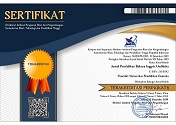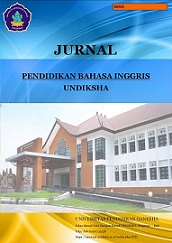AN ANALYSIS OF TEACHER’S LESSON PLAN FOR LEARNING ENGLISH THROUGH GOOGLE CLASSROOM IN JUNIOR HIGH SCHOOL
DOI:
https://doi.org/10.23887/jpbi.v9i1.36343Keywords:
Lesson Plan, Learning English, Google ClassroomAbstract
Online learning is something new for teachers and students, so there are various obstacles to it. This study aims to: analyze the preparation of EFL teachers in preparing lesson plans and identify and describe teacher difficulties in preparing lesson plans for EFL students. This study uses a qualitative descriptive research design. Data on teacher preparation and difficulties faced by teachers in preparing lesson plans were taken using a questionnaire by determining five aspects, namely: 1) learning objectives, 2) learning materials, 3) learning activities, 4) media and learning resources and, 5) learning assessment. The study results are that the teacher fulfills all the steps in compiling a one-page lesson plan, which fulfills the steps provided by the instrument. Regarding the problems faced in the process of preparing lesson plans by teachers, it can be synthesized that there are six difficulties encountered by teachers, such as 1) stating learning objectives that contain behavior (B), 2) connecting learning objectives to core competencies, 3) compiling learning materials based on indicators. Learning, 4) selection of learning media based on learning objectives, 5) selection of learning media based on learning materials, and 6) selection of assessment based on learning objectives.
References
Agustuna, N. E., Herlina, R., & Faridah, D. (2019). Corrective Feedback on Pronunciation Errors: Teacher’s Perception and EFL High School Students’ Self-Reflection. Journal Of English Education And Teaching, 3(3). https://doi.org/10.33369/jeet.3.3.311-327
Aina, & Tuti. (2020). Improving Teacher Performance In Classroom Learning Process Through Collaborative Educational Supervisions In Elementary Schools. Primary Jurnal Pendidikan Guru Sekolah Dasar, 9(2). https://doi.org/10.33578/jpfkip.v9i2.7894
Albashtawi, A. H., & Al Bataineh, K. B. (2020). The effectiveness of google classroom among EFL students in Jordan: An innovative teaching and learning online platform. International Journal of Emerging Technologies in Learning, 15(11), 78–88. https://doi.org/10.3991/IJET.V15I11.12865
All, A., Castellar, E. N. P., & Looy, J. Van. (2021). Digital Game-Based Learning effectiveness assessment: Reflections on study design. Computers & Education, 167. https://doi.org/10.1016/j.compedu.2021.104160
Andini, S., Budiyono, & Fitriana, L. (2018). Developing flipbook multimedia: The achievement of informal deductive thinking level. Journal on Mathematics Education, 9(2), 227–238. https://doi.org/10.22342/jme.9.2.5396.227-238
Artacho, E. G., Martínez, T. S., Ortega Martín, J. L., Marín Marín, J. A., & García, G. G. (2020). Teacher training in lifelong learning-the importance of digital competence in the encouragement of teaching innovation. Sustainability (Switzerland), 12(7), 1–13. https://doi.org/10.3390/su12072852
Backfisch, I., Lachner, A., Hische, C., Loose, F., & Scheiter, K. (2020). Professional knowledge or motivation? Investigating the role of teachers’ expertise on the quality of technology-enhanced lesson plans. Learning and Instruction, 66. https://doi.org/10.1016/j.learninstruc.2019.101300
Bin-Hady, W. R. A., & Abdulsafi, A. S. T. (2019). How Can I Prepare an Ideal Lesson-Plan? SSRN Electronic Journal, 7(4). https://doi.org/10.2139/ssrn.3434031
Contreras, K., Arredondo, C., Díaz, C., Inostroza, M. J., & Strickland, B. (2020). Examining differences between pre- and in-service teachers’ cognition when lesson planning. System, 91. https://doi.org/10.1016/j.system.2020.102240
Evriana, L. (2020). The Implementation of Online Assessment in English Lesson at 10th Grade Student of SMA Nasional 3 Bahasa Putera Harapan. State Institute of Islamic Studies Purwokerto.
Faizah, U., Zuchdi, D., & Alsamiri, Y. (2019). An authentic assessment model to assess kindergarten students’ character. Research and Evaluation in Education, 5(2), 103–119. https://doi.org/10.21831/reid.v5i2.24588
Fitriyanti, A. N. (2019). The Problems Faced by English Teachers in Making Lesson Plan. Makassar Muhammadiyah University.
Flores, J. A. A. (2021). The semiotics of writing: How adult L2 learners with emergent literacy make meaning in assessment texts through writing. Journal of Second Language Writing, 51. https://doi.org/10.1016/j.jslw.2021.100793
Friedman, L. W., & Friedman, H. H. (2013). Using social media technologies to enhance online learning. Journal of Educators Online, 10(1). https://doi.org/10.9743/JEO.2013.1.5
Grunewald, K., Bastian, O., Louda, J., Arcidiacono, A., & Brzoska, P. (2021). Lessons learned from implementing the ecosystem services concept in urban planning. Ecosystem Services, 49. https://doi.org/10.1016/j.ecoser.2021.101273
Guswara, A. M. (2020). The Contribution of Google Classroom Application and Motivation to The Learning Outcomes of Web Programming. Educational Technology, 4(4), 1–9. https://doi.org/10.23887/jet.v4i4.29896
Harmer, J. (2007). The Practice of English Language Teaching (Fourth Edition). Pearson Education Ltd.
Hatch, L., & Clark, S. K. (2021). A study of the instructional decisions and lesson planning strategies of highly effective rural elementary school teachers. Teaching and Teacher Education, 108. https://doi.org/10.1016/j.tate.2021.103505
Iqbal, M. H., Siddiqie, S. A., & Mazid, M. A. (2021). Rethinking theories of lesson plan for effective teaching and learning. Social Sciences & Humanities Open, 4(1). https://doi.org/10.1016/j.ssaho.2021.100172
Istiqomah, F. (2018). Analisis Kemampuan Menyusun RPP Kurikulum 2013 pada Mahasiswa Pendidikan Kimia FKIP Universitas Tanjungpura. Universitas Tanjungpura.
Khalil, Z. M. (2018). EFL Students’ Perceptions towards Using Google Docs and Google Classroom as Online Collaborative Tools in Learning Grammar. Applied Linguistics Research Journal, 2(2), 33–48. https://doi.org/10.14744/alrj.2018.47955
Kubilinskiene, S., & Dagiene, V. (2010). Technology-Based Lesson Plans: Preparation and Description. Informatics in Education, 9(2), 217–228. https://doi.org/10.15388/infedu.2010.15
Latifa, I. S. (2017). The Analysis of Teachers’ Lesson Plan through Behavioral Objectives Theory. Advances in Social Science, Education and Humanities Research (ASSEHR), 82(1), 6–11. http://dx.doi.org/10.2991/conaplin-16.2017.2
Lauc, T., Jagodić, G. K., & Bistrović, J. (2020). Effects of Multimedia Instructional Message on Motivation and Academic Performance of Elementary School Students in Croatia. International Journal of Instruction, 13(4), 491–508. https://doi.org/10.29333/iji.2020.13431a
Marino, M. P., & Crocco, M. S. (2020). The pre-service practicum experience and inquiry-oriented pedagogy: Evidence from student teachers׳ lesson planning. The Journal of Social Studies Research, 44(1). https://doi.org/10.1016/j.jssr.2019.02.001
Mastra, I. N. (2019). Peningkatan Kinerja Guru Dalam Penyusunan Rencana Pelaksanaan Pembelajaran (RPP) Melalui Pendampingan Klasikal Dan Individual Di SD Negeri 26 Ampenan Semester SAtu Tahun Pelajaran 2017/2018. Jurnal Ilmiah Mandala Education, 5(2). https://doi.org/10.36312/jime.v5i2.755.
Masyithah, H., Muchtar, Z., & Mahmud. (2015). Pengaruh Penerapan Multimedia Camtasia Studio dan Media Power Point terhadap Aktivitas dan Hasil Belajar Siswa pada Materi Struktur Atom. Jurnal Pelangi Pendidikan, 8(2). https://doi.org/10.24114/pelangi.v22i2.6217
Maulani, D. R. (2019). The Analysis of Teacher’s Lesson Plan and Its Implementation in the Classroom. Islamic State University Ar-Raniry Banda Aceh.
Mauliate, H. D., Rahmat, A., & Wachidah, S. (2019). Evaluation the Lesson Plan of English Language Learning in Junior High School, Seraphine Bakti Utama West Jakarta. International Journal of Scientific Research and Management, 7(07), 1078–1086. https://doi.org/10.18535/ijsrm/v7i7.el02
Mulatsih, B. (2020). Penerapan Aplikasi Google Classroom, Google Form, dan Quizziz dalam Pembelajaran Kimia di Masa Pandemi Covid-19. Ideguru : Jurnal Karya Ilmiah Guru, 5(1).
Mulyani, M. (2013). An Analysis of English Lesson Plan Academic Year 2012/2013 at the First Semester of MAS Darul Ulum, Banda Aceh. Syiah Kuala University.
Nordgren, K., Kristiansson, M., Liljekvist, Y., & Bergh, D. (2021). Collegial collaboration when planning and preparing lessons: A large-scale study exploring the conditions and infrastructure for teachers’ professional development. Teaching and Teacher Education, 108. https://doi.org/10.1016/j.tate.2021.103513
Nur Utami, K., & Mustadi, A. (2017). Pengembangan Perangkat Pembelajaran Tematik Dalam Peningkatan Karakter, Motivasi, Dan Prestasi Belajar Siswa Sekolah Dasar. Jurnal Pendidikan Karakter, 7(1), 14–25. https://doi.org/10.21831/jpk.v7i1.15492
Nurtanto, M., Kholifah, N., Masek, A., Sudira, P., & Samsudin, A. (2021). Crucial problems in arranged the lesson plan of vocational teacher. International Journal of Evaluation and Research in Education (IJERE), 10(1), 345–354. https://doi.org/10.11591/ijere.v10i1.20604
Oktafianti, T. (2019). An Analysis of Lesson Plan made by an English Teacher referring to Curriculum 2013 at MTS Al-Qur’an Harsallakum Bengkulu in Academic Year 2018/2019. State Institute for Islamic Studies (IAIN) Bengkulu.
Rasmawan. (2018). Development of Chemistry Module for Junior High School Based on Inquiry Accompanied by Performance-Based Assessment. Jurnal Pendidikan Indonesia, 7(2), 111–119. https://doi.org/10.23887/jpi-undiksha.v7i2.10617
Raynesa Noor Emiliasari. (2019). Lesson Planning in EFL Classroom: A Case Study in Lesson Plan Preparation and Implementation. Wiralodra English Journal, 3(2), 367–375. https://doi.org/10.31943/wej.v3i2.67
Santosa, F. H., Negara, H. R. P., & Samsul Bahri. (2020). Efektivitas Pembelajaran Google Classroom Terhadap Kemampuan Penalaran Matematis Siswa. Jurnal Pemikiran Dan Penelitian Pendidikan Matematika (JP3M), 3(1), 62–70. https://doi.org/10.36765/jp3m.v3i1.254
Saputri, D. F., Fadillah, S., Nurhayati, N., & Nurussaniah, N. (2019). Pelatihan Pembuatan Lesson Plan dan Media Pembelajaran bagi Guru di Sekolah Dasar Negeri 34 Pontianak Kota (Workshop on Creating Lesson Plans and Making Learning Media for Teachers at 34 Elementary Schools in Pontianak City). ABDIHAZ: Jurnal Ilmiah Pengabdian Pada Masyarakat, 1(1), 22–27. https://journals.unihaz.ac.id/index.php/abdihaz/article/view/747
Sari. (2017). Pengaruh Model Pembelajaran Kooperatif Tipe Nht Berbantuan Question Cards Terhadap Kompetensi Pengetahuan IPA. Mimbar PGSD Undiksha, 5(2). https://doi.org/10.23887/jjpgsd.v5i2.10660
Schmid, M., Brianza, E., & Petko, D. (2021). Self-reported technological pedagogical content knowledge (TPACK) of pre-service teachers in relation to digital technology use in lesson plans. Computers in Human Behavior, 115. https://doi.org/10.1016/j.chb.2020.106586
Segers, M., Martens, R., & Bossche, P. Van den. (2018). Understanding how a case-based assessment instrument influences student teachers’ learning approaches. Teaching and Teacher Education, 4(3). https://doi.org/10.1016/j.tate.2008.02.022
Sesiorina, S. (2014). The analysis of teachers’ lesson plan in implementing theme-based instruction for teaching English to young learners. Journal of English and Education, 2(1), 84–95. https://ejournal.upi.edu/index.php/L-E/article/view/750
Setiawan, I. M. D., & Ari Oka, I. D. G. (2020). The Use of Audio-Visual Assisted Google Classroom for Mathematics Course. Journal of Education Technology, 4(3), 244. https://doi.org/10.23887/jet.v4i3.28529
Shen, J., Poppink, S., Cui, Y., & Fan, G. (2007). Lesson Planning : A Practice of Professional Responsibility and Development. Educational Horizons.
Soni, Hafid, Hayami, Fatma, Wenando, Amien, Fuad, Unik, & Mukhtar. (2018). Optimalisasi Penggunaan Google Classroom, E-Learning & Blended Learning sebagai Media Pembelajaran Bagi Guru dan Siswa di SMK Negeri 1 Bangkinang. Jurnal Pengabdian Untukmu Negeri, 21. https://doi.org/10.37859/jpumri.v2i1.361
Suciati, S. (2020). Peningkatan Kreatfitas dan Inisiatif Guru melalui Model Pembelajaran Daring pada masa Pandemi Covid-19. Ideguru: Jurnal Karya Ilmiah Guru, 5(1), 79–85.
Suh, H. (2011). Collaborative Learning Models and Support Technologies in the Future Classroom. International Journal, 5(1), 50–61.
Usmanova, N., Shindina, T., & Basharina, A. (2015). Development and Assessment of Interactive Teaching Approach Impact on Communicative Competence of Bachelors of Economic Universities. Procedia - Social and Behavioral Sciences, 214. https://doi.org/10.1016/j.sbspro.2015.11.701
Utami, N. W., Sayuti, S. A., & Jailani, J. (2021). Indigenous artifacts from remote areas, used to design a lesson plan for preservice math teachers regarding sustainable education. Heliyon, 7(3). https://doi.org/10.1016/j.heliyon.2021.e06417
Wikanengsih, Nofiyanti, & Permana. (2015). Analisis Rencana Pelaksanaan Pembelajaran (Rpp) Mata Pelajaran Bahasa Indonesia (Studi Terhadap Rpp Yang Disusun Guru Bahasa Indonesia Tingkat SMP Di Kota Cimahi. Jurnal Ilmiah P2M STKIP Siliwangi P2M STKIP Siliwangi, 2(1). https://doi.org/10.22460/p2m.v2i1p106-119.170
Zazkis, R., Liljedahl, P., & Sinclair, N. (2009). Lesson Plays: Planning Teaching versus Teaching Planning. For the Learning of Mathematics, 29(1), 40–47. https://www.jstor.org/stable/40248639
Downloads
Published
Issue
Section
License
Authors who publish with the Jurnal Pendidikan Bahasa Inggris Undiksha agree to the following terms:- Authors retain copyright and grant the journal the right of first publication with the work simultaneously licensed under a Creative Commons Attribution License (CC BY-SA 4.0) that allows others to share the work with an acknowledgment of the work's authorship and initial publication in this journal
- Authors are able to enter into separate, additional contractual arrangements for the non-exclusive distribution of the journal's published version of the work (e.g., post it to an institutional repository or publish it in a book), with an acknowledgment of its initial publication in this journal.
- Authors are permitted and encouraged to post their work online (e.g., in institutional repositories or on their website) prior to and during the submission process, as it can lead to productive exchanges, as well as earlier and greater citation of published work. (See The Effect of Open Access)













